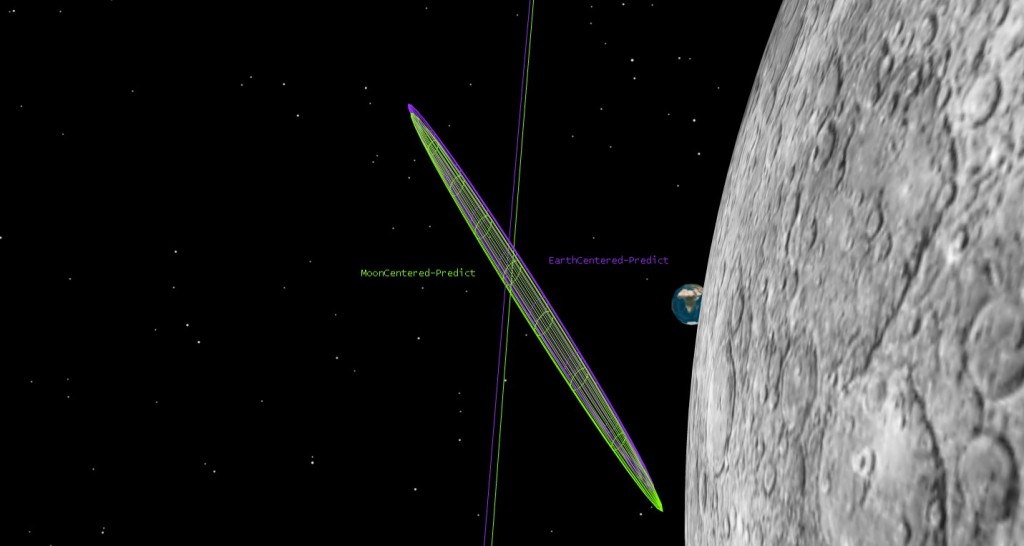5.5 Hrs to LOI
Watch the Lunar Orbit Period and Lunar Apoapsis Altitude come down once the Lunar Eccentricity goes below 1.0 (from Hyperbolic to Elliptical).
The Moon is now under control. Based on LADEE’s altitude (below 66,000 km) the Moon is now the primary gravitational body acting on the spacecraft. In other words, the Moon’s gravity is now stronger than the Earth’s.
This picture really shows the change the Moon is imposing on the orbit, which until now had been a large elliptical orbit around the Earth:
Note that the white arc LADEE is currently on turns red when LADEE gets below 50,000 km. After that, you can see another short, white arc on the trajectory which is Lunar Orbit Insertion 1, or LOI-1.
Here’s LADEE’s view of the Earth:
And finally, the approach trajectory:
You can see the LOI-1 arc in this view as well.
About 15 hrs to LOI-1 now….

This figure, created a few days ago, shows the Earth- and Moon-centered orbit estimates. It also shows the uncertainty in these estimates. The uncertainty is very small, although it’s hard to see the scale in this picture since we zoomed in to show it. The uncertainty is shown as a 3 dimensional region in space that represents where LADEE is most likely to be. The region in the picture is only a few hundred meters long, using the estimate from several days ago (it’s smaller now).
As we mentioned previously, we’re not quite within the Moon’s sphere of influence yet. (LADEE will be within most definitions of the Moon’s sphere of influence by 19:30 UTC today, October 5th.) Even so, we’ve been modeling the significant effects of the Moon’s gravity on our trajectory since we launched. The way we modeled it, as is standard, was as if the Moon is a perfect sphere. In reality, however, we know from all the previous lunar missions that the Moon’s gravity field is quite “lumpy” and when we are in orbit around the Moon, we will model the Moon’s gravity with many more equations than we did when LADEE was close to Earth. As we approach the Moon, we have to transition from considering the Earth’s gravity as dominant to the Moon’s gravity as the primary effect. For trajectory design purposes we’ve been switching from an Earth-centered orbit propagation to a Moon-centered orbit propagation when LADEE gets within 50,000 km of the Moon’s center. (Our analysis has shown that this number doesn’t have to be very precise to meet the accuracy requirements. On the Clementine lunar mission we didn’t switch to a Moon-centered orbit propagation until we captured at Lunar Orbit Insertion.)
In addition to calculating the trajectories, we also have to track LADEE and estimate the orbit, using a technique called “Orbit Determination.” Fellow Astrogators Lisa Policastri, Ryan Lebois, and Craig Nickel work with us on this. The method we use is an Extended Kalman Filter, which processes tracking data sequentially as we receive the data from the tracking stations around the world. Orbit Determination is sort of like curve fitting, and one of our jobs is to estimate the trajectory that best fits the tracking data. As you can see from the pictures we’ve posted previously, LADEE’s trajectory bends a lot as it goes from the Earth’s influence to the Moon’s. To model the changing gravity for Orbit Determination, we decided to do something different than we do for trajectory design. Instead of switching from Earth-Centered to Moon-centered at a specified point, a few days ago we started running two algorithms side-by-side; one Earth-centered, and one Moon-centered. We trend the two different orbit estimates, and by the time we reach the LOI1 maneuver (6 Oct 2013 10:57 UTC), which is just past periselene, we will be ready to transition to using the Moon-centered algorithm for the rest of the mission.